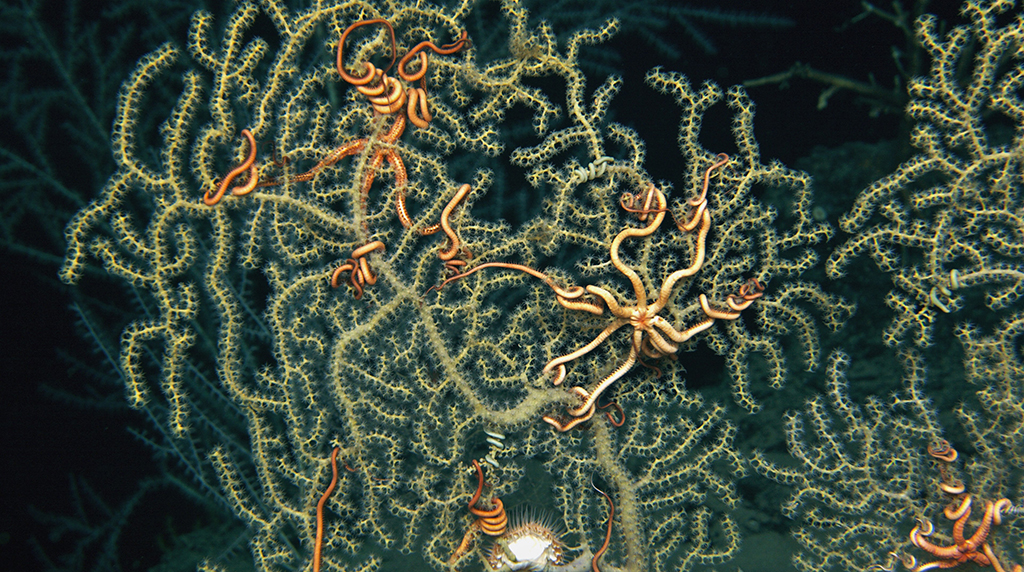February 07, 2017
Pennsylvania State University scientists analyzed images of impacted and non-impacted deep sea corals to characterize their symbiotic relationship with brittle stars and determine if brittle stars influenced coral recovery from the Deepwater Horizon spill. The researchers observed that corals associated with brittle stars were healthier than corals that were not. Corals with brittle stars settled on them exhibited less visible impact and a greater incidence of recovery compared to corals with no brittle stars, likely a result of the brittle stars removing deposited material and inhibiting hydroid settlement. The scientists published their findings in Marine Ecology Progress Series: Mutualistic symbiosis with ophiuroids limited the impact of the Deepwater Horizon oil spill on deep-sea octocorals.
Coral communities are considered hotspots of biodiversity and provide a habitat and food source for other species. Deep-sea corals can form large aggregates, similar to forests, and can live for thousands of years. However, the corals’ high longevities are associated with very slow growth rates making them vulnerable to environmental impacts. Most Paramuricea biscaya coral colonies – the coral species most impacted by the Deepwater Horizon oil spill – are associated with one species of brittle star, Asteroschema clavigerum. While previous studies suggest that brittle stars could use their shallow-water host corals to rise above the sea floor and gain better access to food, few studies have suggested that corals could also benefit from their association with brittle stars. This study seeks to better understand coral’s responses to anthropogenic impacts and interactions with other organisms and provide insights on protecting them.
Researchers used remotely operated vehicles during seven research cruises between 2011 and 2014 to obtain high-resolution images of corals at three impacted and one non-impacted sites. They digitized the images and coded coral branches as either visibly impacted (excess mucus, bare skeleton, absence of polyps), colonized by hydroids, or not visibly impacted. They then calculated the total visible impact based on the proportion of branches that were colonized by hydroids or otherwise visibly impacted. They developed a method to define an area under the influence of brittle stars for each coral, and compared impact as well as recovery within and outside that area.
The team observed high fidelity between corals and brittle stars at most sites, with 91–100% of brittle stars staying on the same coral over time. While some brittle stars on heavily-impacted corals left their host or died during the year that followed the spill, most stayed on their host coral regardless of oiling. Within a coral colony, branches located near a brittle star were healthier and, if impacted, were more likely to recover. Coral recovery from visible impact decreased as a coral’s distance from a brittle star increased.
This study demonstrates the importance of brittle stars to coral health and provides evidence that brittle stars protect deep-sea corals and facilitate their recovery from impacts and the only such study on a deep-water coral species. The researchers suggested that these benefits could also apply to corals exposed to natural sedimentation events or other anthropogenic stressors as well as to shallow water corals. “Our study reinforces the fact that biodiversity is important to the health of an ecosystem and that damage to individual species can have wide-ranging effects on entire communities,” said study author Fanny Girard.
Data are publicly available through the Gulf of Mexico Research Initiative Information and Data Cooperative (GRIIDC) at doi: 10.7266/N7NG4NJP, 10.7266/N7HQ 3WVD, 10.7266/N7D21VJQ, 10.7266/N78913TC, 10.7266/N74J0C2M).
The study’s authors are Fanny Girard, Bo Fu, and Charles R. Fisher.
************
This article was written by Maggie Dannreuther and originally appeared online here.
This research was made possible in part by a grant from the Gulf of Mexico Research Initiative (GoMRI) to the Ecosystem Impacts of Oil and Gas Inputs to the Gulf-2 (ECOGIG-2) consortium.
The Gulf of Mexico Research Initiative (GoMRI) is a 10-year independent research program established to study the effect, and the potential associated impact, of hydrocarbon releases on the environment and public health, as well as to develop improved spill mitigation, oil detection, characterization and remediation technologies. An independent and academic 20-member Research Board makes the funding and research direction decisions to ensure the intellectual quality, effectiveness and academic independence of the GoMRI research. All research data, findings and publications will be made publicly available. The program was established through a $500 million financial commitment from BP. For more information, visit http://gulfresearchinitiative.org/.


















 back to top
back to top